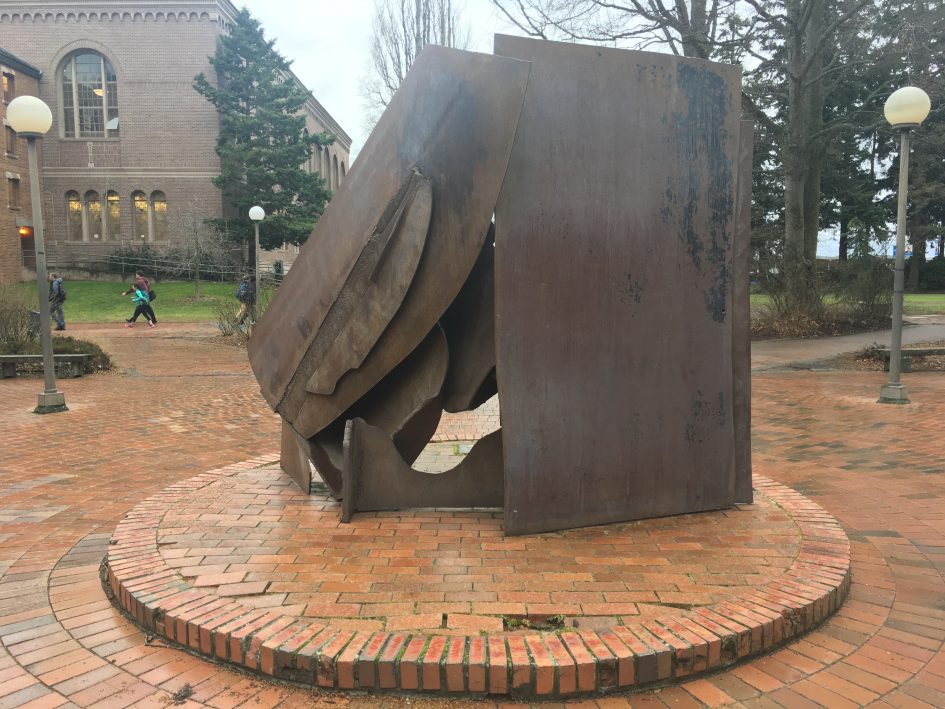Artist
Anthony Caro was an abstract/modern artist born March 8, 1924 in New Malden, Surrey. Modernism in other terms is: originality, truth, tradition, linear, and more centered. Anthony is known for minimalism, this can represent his sculptures because he only added what he needed for the audience to understand his interpretation and message. His practice begins the moment he leaves grade school, heading off to attend Christ’s College in Cambridge where he studies engineering (1942). Spending vacations in the studio of a sculptor by the name Charles Wheeler, we see a clear interest towards tangible art and creation early on. While previously dealing with mostly clay and plaster until this point, roughly eighteen years later we see his first abstract sculptures appear.
The definite change in ideals came a year earlier due to his first visit to the United States in 1959, and more prominently the introduction to a local artist, David Smith. Meeting many other abstract expressionists during his visit, David primarily made steel sculptures. “Caro has been impressing his own conceptions, his own personality and sensibility, on his work that has freely incorporated in its elements shaped by Smith” (Caro, Anthony, and William Rubin, p.30). Along with this, Caro’s heavily influenced Picasso-like paintings leaked their way into his three-dimensional work. Relating to WWU’s own, India (1976), the influence did not contribute to this construction directly after his initial turn.
The distinct style Caro uses comes in around the 1970’s when, assisted by James Wolfe and Willard Boepple, makes works such as The Bull, Pink Stack, Orangerie, and Sun Feast. All of which being the same kind of unpainted, rusted steel and varnished types we see in our example, he begins the Straight series (1972) soon thereafter. These fourteen pieces made with soft edge roll end steel include India as one of the later productions. Caro used steel because it was a structural necessity for many of his pieces. He would have liked to find a new material that was completely anonymous, without associations to itself”, as he mentioned while creating the sculptures in the 1970’s. Caro’s sculptures in 1976 were “compromised by the amorphous tactility of massive steel structure insertions” (Fenton, Terry, and Anthony Caro). He found himself at one of the limits of sculptural expression during this period.
Some examples of Caro’s work include painted sculptures, such as “Sun Feast”, but India did not have this commonality, it is merely rusted and stained steel, like others in this production of steel sculptures. The particular India piece had massive thickness as if he wanted the “very weight and substance of steel to convey a kind of primordial sculptural expression”, in comparison to his sculptures from the 1960’s which tended to be open, linear, and painted, much like modernist work.
He had a unique ability to compose with long, straight rods and planes that both penetrated and occupied space. (Fenton, Terry, and Anthony Caro). Some of these explanations can relate to the interpretation and similarity of the way India was created. India, located on WWU’s north campus stands tall between Old Main and the Humanities building, directing lighting of all kinds throughout the day. This sculpture is three-dimensional, it creates space, different light, and texture.
It is particularly important to recognize the time periods prior to 1976, because of the certain art movements that occurred, such as in the 1920’s ‘modern sculpture’ art was being recognized, and in the 50’s and 60’s artists became more experimental with materials. Possibly on the forefront with time pertaining to style, Caro transformed his materials, medias, and mediums over the course of his life. Although he has worked with a variety of mediums he often works with steel. Some of the others are bronze, silver, lead, stoneware, wood, and even paper. Caro really sets standards for us because of his creations and how they are “both wholly his own and firmly rooted in the history of modernism.” (Wilkin, Karen, Anthony Caro, John Riddy, and Ian Barker”.
Anthony Caro’s life came to an end on October 23, 2013. Many individuals will remember his name and the impact he made in the art and sculpturing worldwide.
Photos


Video
Bibliography
Hansen, Siri Fischer. “Anthony Caro- Sculpture.” Biography. KYPS, 2016. Web. 25 Apr. 2017.
Caro, Anthony, and William Rubin. Anthony Caro. New York: Museum of Modern Art, 1975. Print.
Fenton, Terry, and Anthony Caro. Anthony Caro. London: Thames and Hudson, 1986. Print.
Wilkin, Karen, Anthony Caro, John Riddy, and Ian Barker. Caro. Munich: Prestel, 1992. Print.
Created by
Hannah Walhmark – research, editor
Macall Prengel – admin, organizer
Kyle Hummel – video, photos




Leave a Reply